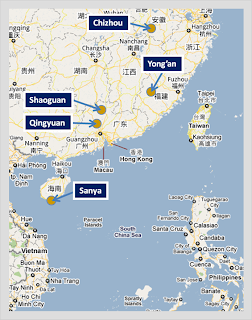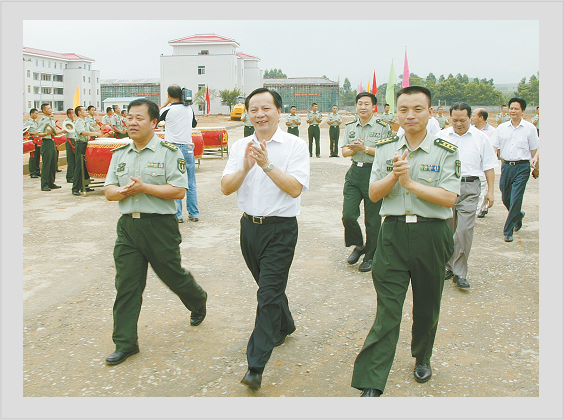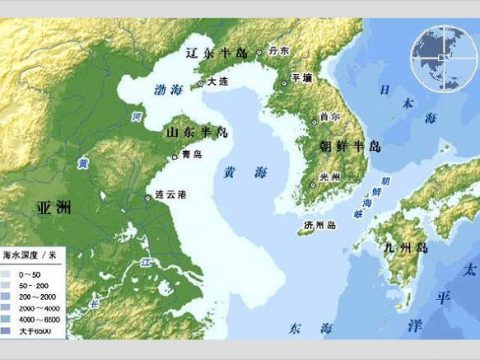
Asia’s Turbulent Waters: Blue Water Tensions in the Yellow Sea
July 29, 2010
ECFA and Beyond
August 13, 2010By: Mark Stokes and Tiffany Ma |
As the PRC’s Ministry of National Defense seems to be warming to the notion of discussing a possible withdrawal of missiles opposite Taiwan, the People’s Liberation Army’s (PLA) primary strategic strike force, the Second Artillery, is continuing to beef up its arsenal despite the cross-Strait political détente following the Economic Cooperation Framework Agreement (ECFA).
Although the introduction of the 1,700km range solid fuelled, terminally guided DF-21C ballistic missile into Guangdong is possible, the brigade is also a candidate to be the first unit equipped with the DF-21D anti-ship ballistic missile (ASBM). The DF-21C, first introduced into the active inventory in 2005, is designed to attack fixed targets on land. If an ASBM is successful in passing the necessary design reviews and a sufficient sensor network is in place, the Shaoguan brigade could become the first in the PLA to field a lethal capability against moving targets at sea out to a range of 1,500-2,000km or more from launch sites.Last week, China’s state-run media quietly announced the construction of facilities for a new Second Artillery missile brigade – the 96166 Unit – in the northern Guangdong municipality of Shaoguan [韶关]. Although the province is already home to a Second Artillery short-range ballistic missile (SRBM) brigade (the 96169 unit in Meizhou), initial reports and indicators signal that the new unit could have unique capabilities that could complicate the strategic calculus in Asia, and the South China Sea in particular.
There are indications that the research and development (R&D) stage of the DF-21D is near completion and it is close to low rate initial production. A new DF-21D solid rocket motor production facility in Inner Mongolia was completed in 2009 and Admiral Robert Willard, Commander of the U.S. Pacific Command, testified before the House and Senate Armed Services Committees in March 2010 that the ASBM is in its testing phase. The Second Artillery planned to finalize the design of the DF-21D by the end of 2010 and the establishment of a permanent deployment location often coincides with the design finalization of a new missile. However, an initial operational capability is likely a ways off, as a follow-on testing of a prototype design may be needed prior to certification for full-rate production.
When fully equipped, a new Second Artillery brigade in Shaoguan would likely take advantage of the city’s location along major transportation arteries and tunneling through the Nanling [å—å²] Mountains that divide Guangdong and Hunan provinces. A Second Artillery engineering unit known to be responsible for tunneling work under the so-called “Great Wall Project†has been in Shaoguan since as early as 2008.
Although the missile and infrastructure is yet to be fully operational, the Second Artillery has likely assigned a core cadre of officers to prepare for introduction of the new missile. Over the last four years, a select group of officers assigned to the 96166 Unit have been attached to an established DF-21 brigade in Chizhou, southern Anhui province (the 96161 Unit, or 807 Brigade). Presumably, the core cadre has been leveraging the expertise of their hosts to develop tactics, training simulation systems, and maintenance procedures for a new DF-21 variant. During this time, they also likely worked alongside the design team from the China Aerospace Science and Industry Corporation (CASIC), the prime contractor for missile R&D and manufacturing.
Whether the unit is equipped with the DF-21C or the more advanced DF-21D maritime variant, the establishment of a conventionally-capable medium range ballistic missile brigade in Guangdong would decisively expand the Second Artillery’s striking radius. More specifically, it would enable the Second Artillery to support the Central Military Commission to enforce territorial claims in the South China Sea, or strike targets in a Taiwan-related contingency without having to overfly Japanese territory.
Like other Second Artillery brigades, the 96166 unit would likely play a role in a military contingency in the Taiwan Strait. To this end, its leadership was strategically selected from experienced personnel from other brigades with a similar mission. The 96166 Unit’s commander Col Tang Qixing [å”其兴] and deputy commander Tang Guozhong [æ±¤å›½å¿ ] both served in the 96167 Unit, a SRBM brigade based in Yong’an city in Fujian province. The Yong’an brigade is also one of at least five SRBM brigades arrayed against Taiwan.
 |
| Confirmed and possible Second Artillery units |
The 96166 Unit’s move to Shaoguan is not the only recent development that signals a possible broadening of the Second Artillery’s capabilities in alignment with China’s widening ‘core interests’ in the region. The settling of the 96166 Unit in Shaoguan also coincides with the permanent deployment of another possible DF-21-related unit in Guangdong. Similar to the 96166 Unit’s relationship with the DF-21 brigade in Chizhou, a core cadre under the 96219 Unit has been attached to a host DF-21 brigade in Chuxiong, Yunnan Province. Media reports as early as 2007 highlighted the achievements of personnel from the 96219 Unit in developing doctrine and simulation systems for a new missile system. The latest reports indicate that the unit has moved to Guangdong’s Qingyuan municipality, approximately 125 kilometers south of Shaoguan. In addition to the Qingyuan unit, another Second Artillery facility – perhaps a forward deployment base for ground launched cruise missiles – is under construction in the eastern suburbs of Sanya City on Hainan Island.
Although these units will not be fully operational in the short term, the missile buildup in southeastern China is nonetheless profoundly strategic as the PRC seeks to secure its regional interests in the Taiwan Strait and beyond. More specifically, the location of the 96166 Unit may signal an extension of China’s ballistic missile diplomacy into the South China Sea. In light of the recent political ruckus over territorial claims and the public declaration of U.S. interest in the waterway, there are heightened stakes for key players to increasingly assert their national interest in these contested waters.




